Before this fixture, we had already witnessed three other group-stage games that had five or more goals in there, which balances all the 0-0 results out quite nicely. Going into this one, in particular, however, there was the inevitable spotlight on a certain Cristiano Ronaldo. Obviously, he would have been one of the main talking points anyway even without this crazy and surreal storyline that he is involved in, but it felt like the actual occasion of Portugal vs Ghana in a World Cup setting was somewhat overshadowed by it all. Interestingly, though, Ronaldo is the only player that is unattached and without a club at this year’s World Cup, out of over 600 players.
Elsewhere in Group H, we saw one of those 0-0 games we spoke about, with Uruguay and South Korea battling out a stalemate that saw little opportunities on goal. Luckily this game was anything but quiet, with Portugal coming away 3-2 winners in an exciting contest, although it did look like we’d be in danger of another goalless game as the two sides went in at half-time with deadlock yet to be broken. In this tactical analysis, we will provide an analysis of Portugal’s approach on the ball and how they looked to play patiently with a strong grip on the game. We will also analyse the defensive tactics of Ghana and how their depth, line, and energy shifted after conceding.
Lineups
Portugal’s side contains some very familiar names for those who follow the Premier League closely, with clubs such as Manchester United, Manchester City, and Wolves all being represented in this lineup. Fernando Santos set his team up in a 4-3-3 shape that looked to nullify Ghana’s threat. Rúben Dias partnered Danilo Pereira in heart of the back four, with Dias’ City teammate João Cancelo operating from right-back. In midfield, Rúben Neves sat slightly deeper than yet another City player in Bernardo Silva, with Porto’s Otávio completing the middle three. An electric front forward unit of Bruno Fernandes, João Felíx, and Cristiano Ronaldo completed the side.
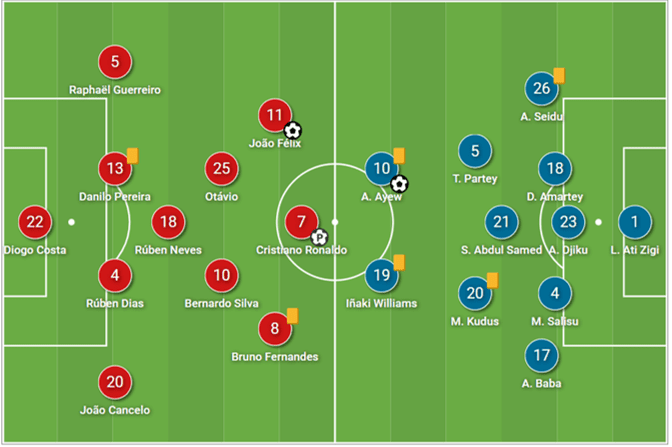
Portugal weren’t the only ones with some exciting players in their lineup. Ghana looked to take the game to their opposition with key players like Ajax’s Mohammed Kudus, who lined up in midfield with Arsenal man Thomas Partey. Another key man was Iñaki Williams. The Bilbao-born striker only declared his Ghanian allegiance last month, while his younger brother Nico is representing Spain.
Meanwhile, a back five that consisted of the versatile Daniel Amartey of Leicester City, Southampton’s Mohammed Salisu, and Alexander Djiku, who plies his trade in France for Strasbourg. Ghana were forced to go with their third-choice goalkeeper Lawrence Ati-Zigi due to injuries.
Portugal’s patient possession approach
Pre-tournament, Portugal were amongst the favourites for many. With success in recent years, a clear tactical philosophy, and a star-studded team, it is not difficult to see why. While we may not see the tiki-taka style of a Pep Guardiola team, or the heavy metal pressing approach of a Jürgen Klopp side, Portugal show comfort and quality in a possession-based approach, utilising clever movement and the exploitation of space to make their mark on the game.
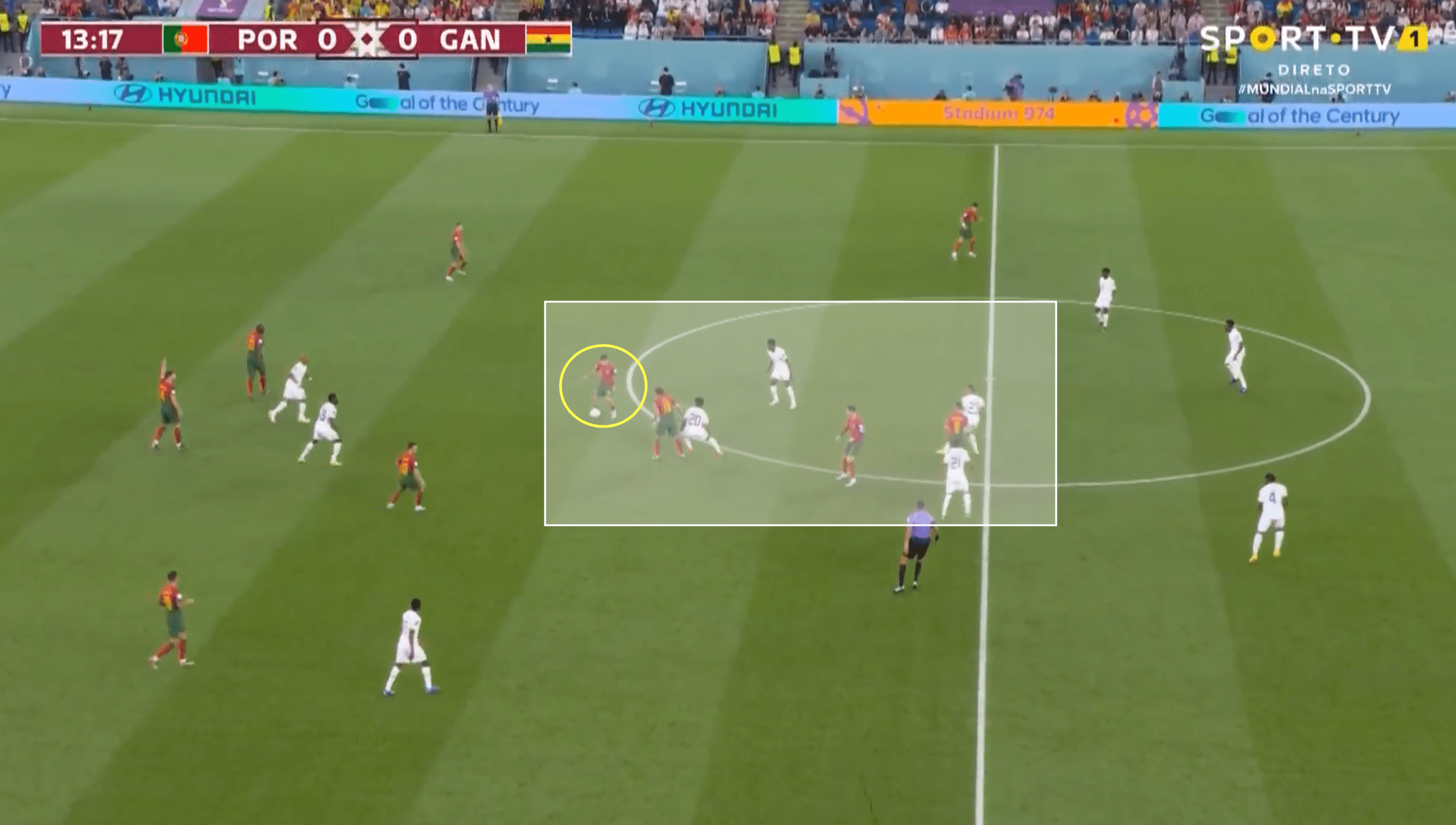
The image above occurred just after a small scrap for possession in the middle of the park, with Portugal prevailing. With a heavy Ghana presence still in that area, composure was key in keeping the ball, along with an idea of a next move.
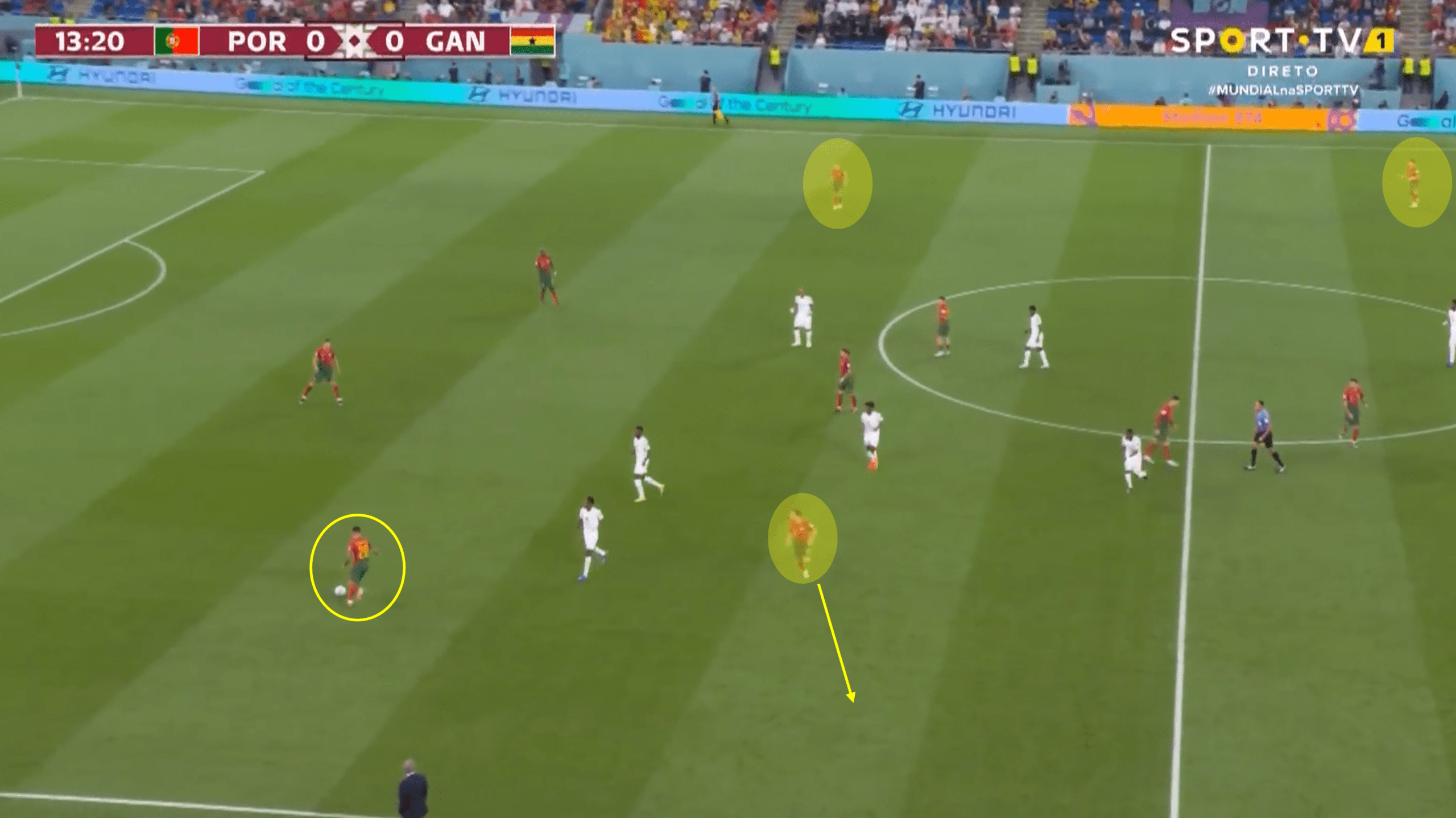
As you can tell by the match clock, within seconds Portugal were able to calm things down and reassert their grip on possession. The ball was played out to right-back Cancelo, and as the ball travelled to him, cogs in the Portugal machine began to turn. Movement in moments like this is what makes Portugal difficult to deal with – there is simply too much to defend, which only provides gaps and chances elsewhere.
Bernardo Silva can be seen drifting out towards the right flank, not necessarily to make himself an option for Cancelo, but to draw out the Ghana midfield. This worked – just look at the presence surrounding Silva, and the rest of Portugal’s midfield for that matter. This is where Portugal’s flexibility and versatility come into play as they incorporate good width into their game. Cancelo showed no hesitation in swinging a pass across the field to Raphaël Guerreiro at left-back, allowing Portugal some breathing space on the ball and the chance to push forward.
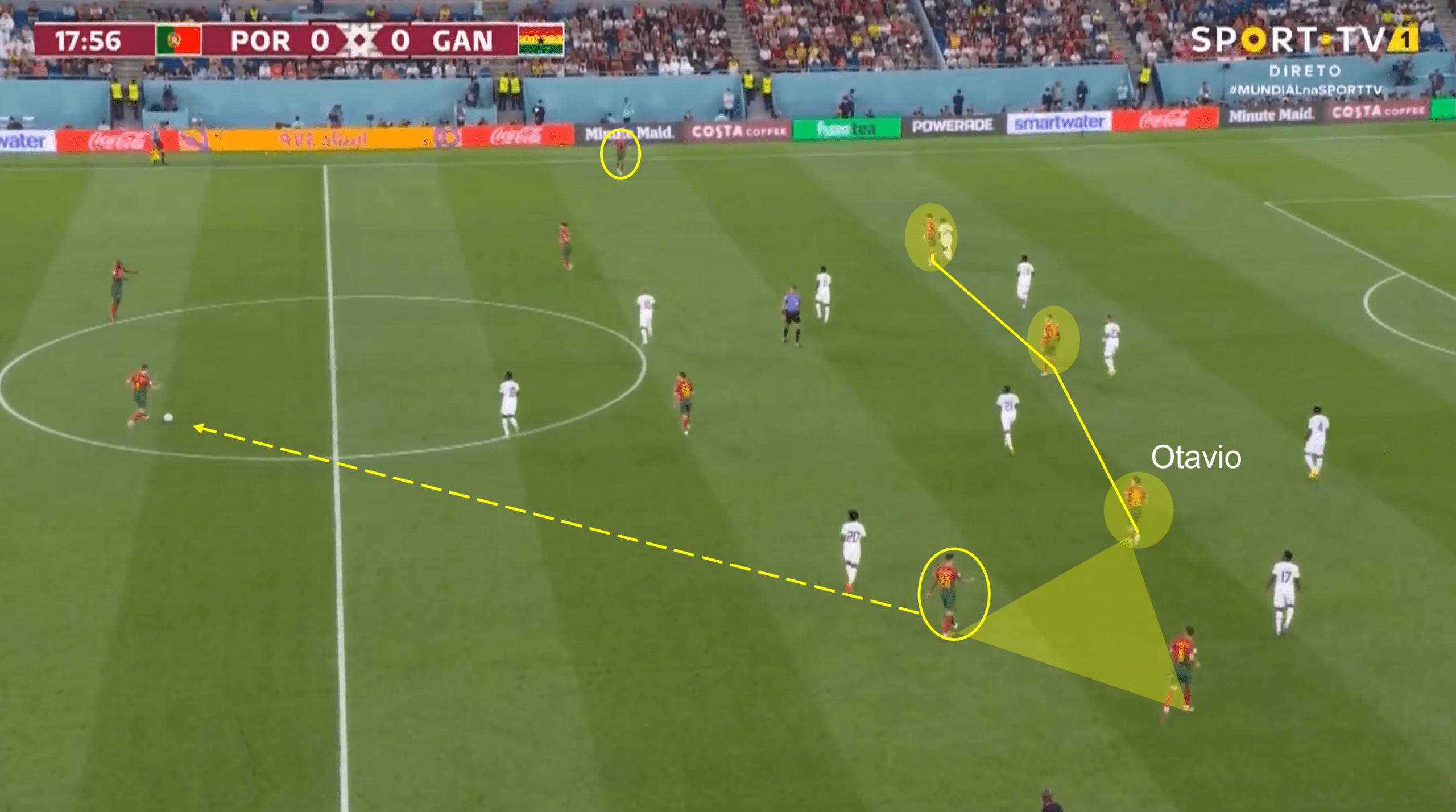
Portugal amassed 61% possession during the game, making a total of 622 passes – 235 more than Ghana’s total. Obviously, Portugal wanted to dictate the game’s tempo and rhythm but knew Ghana would be somewhat prepared for this and the task would not be simple. This is probably why it took 65 minutes to break the deadlock.
Above, we see Portugal in comfortable possession, with the ball at the halfway line, and Ghana forced deeper into their own half. The Ghanaians often showed little width when defending in this way, giving Portugal the opportunity to hit those wide areas.
An interesting pattern of play that Portugal have implemented into their attacking tactics is the movement and positioning in certain areas of attack. For instance, above, Cancelo had just played a backwards pass to Dias (so the ball had arrived from the right flank). While possession was with Cancelo in that area, his teammates formed a shape as they looked to overwhelm and outnumber Ghana in a key area out wide. Otávio (or the central midfielder nearest at the time of execution) would drift forward to act as the makeshift right forward, which would usually be Fernandes, who this time held off in a wider position as he looked to give his side a numerical advantage in that area. While this move did not head in that direction, the intention was clear, and it showed the flexibility and fluidity of the team.
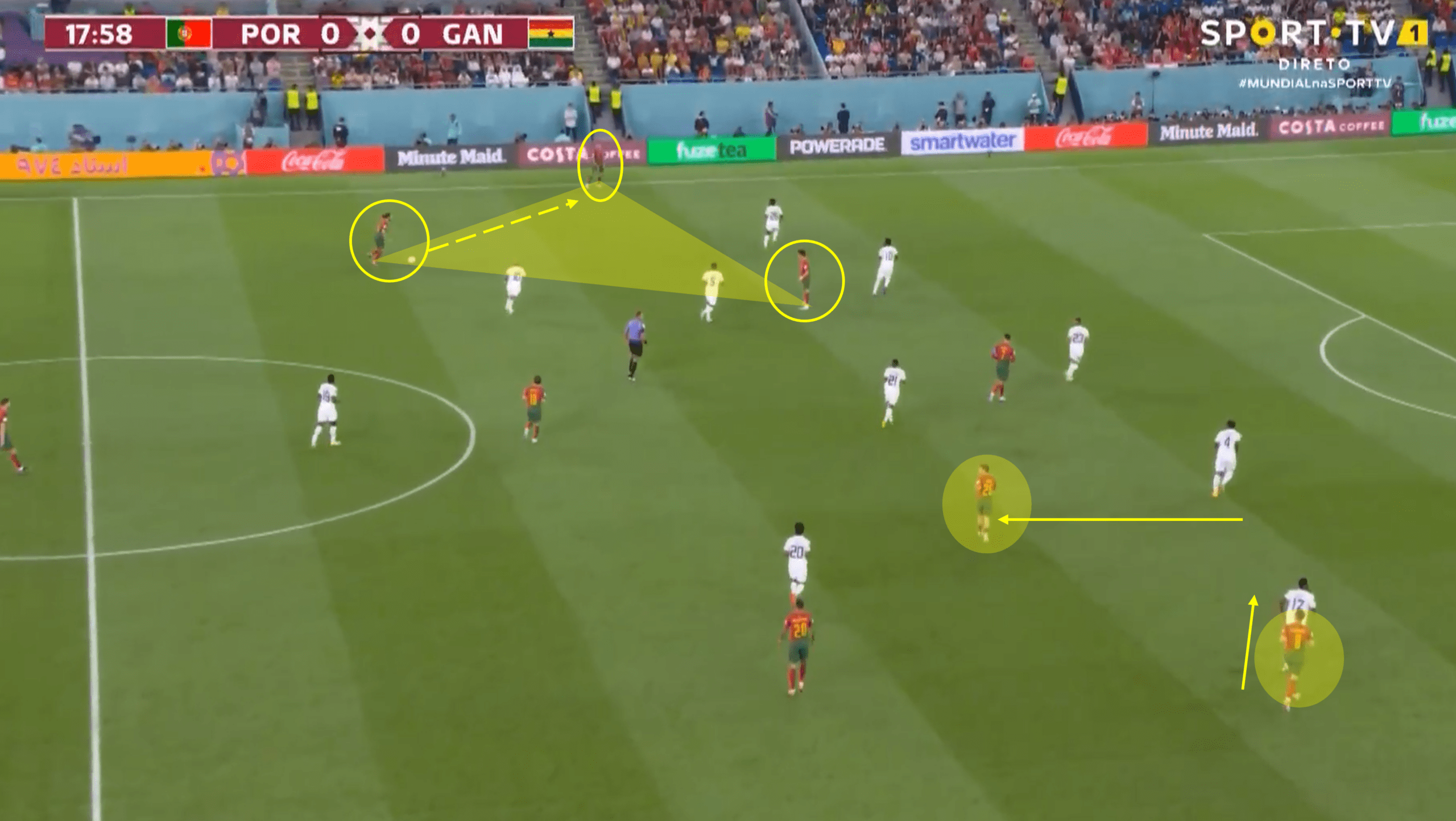
That move saw possession transferred to the left flank of play, and we saw a similar pattern emerge. Neves is the man on the ball and has pushed slightly wider to create another numerical advantage with Guerreiro and Felíx. Not only does this give Portugal more options for combination play in close proximity, but it forces Ghana’s hand in defending it, which can create dangerous space elsewhere.
Also notice how, now that possession has shifted sides, Otávio and Bruno Fernandes reverted to their initial positions, with Fernandes lurking wider still on the flank opposite to the possession.
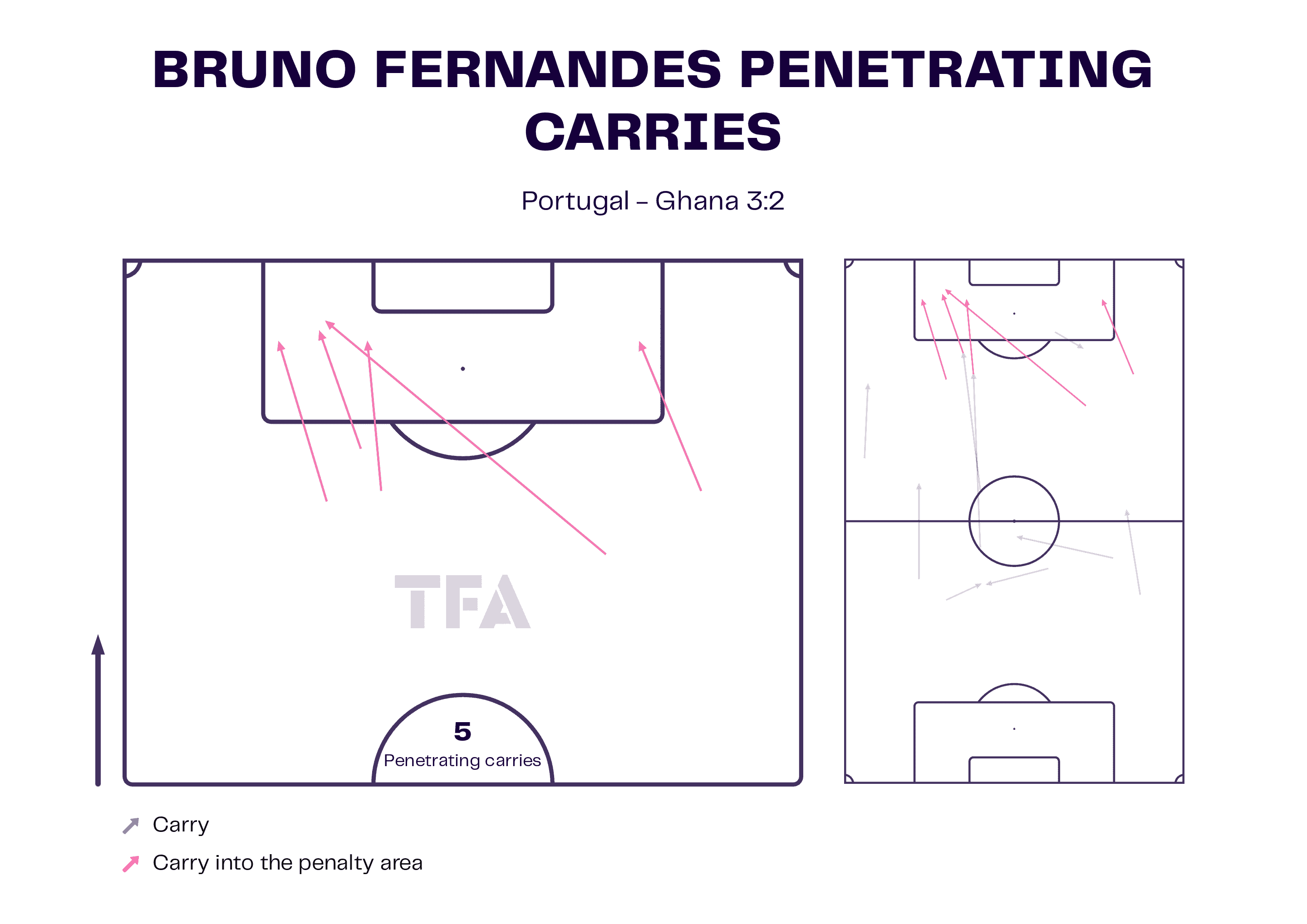
Fernandes was a constant danger in this match and Ghana struggled to contain him. Man of the match for many, the Manchester United man was dazzling on the ball, completing five dangerous carries into the Ghana box. He also completed a number of carries in important midfield areas. Interestingly, all of his five carries into the box took the pattern of drifting/heading to the left, running across the defence. He also made two assists in this match, highlighting his danger from midfield even more.
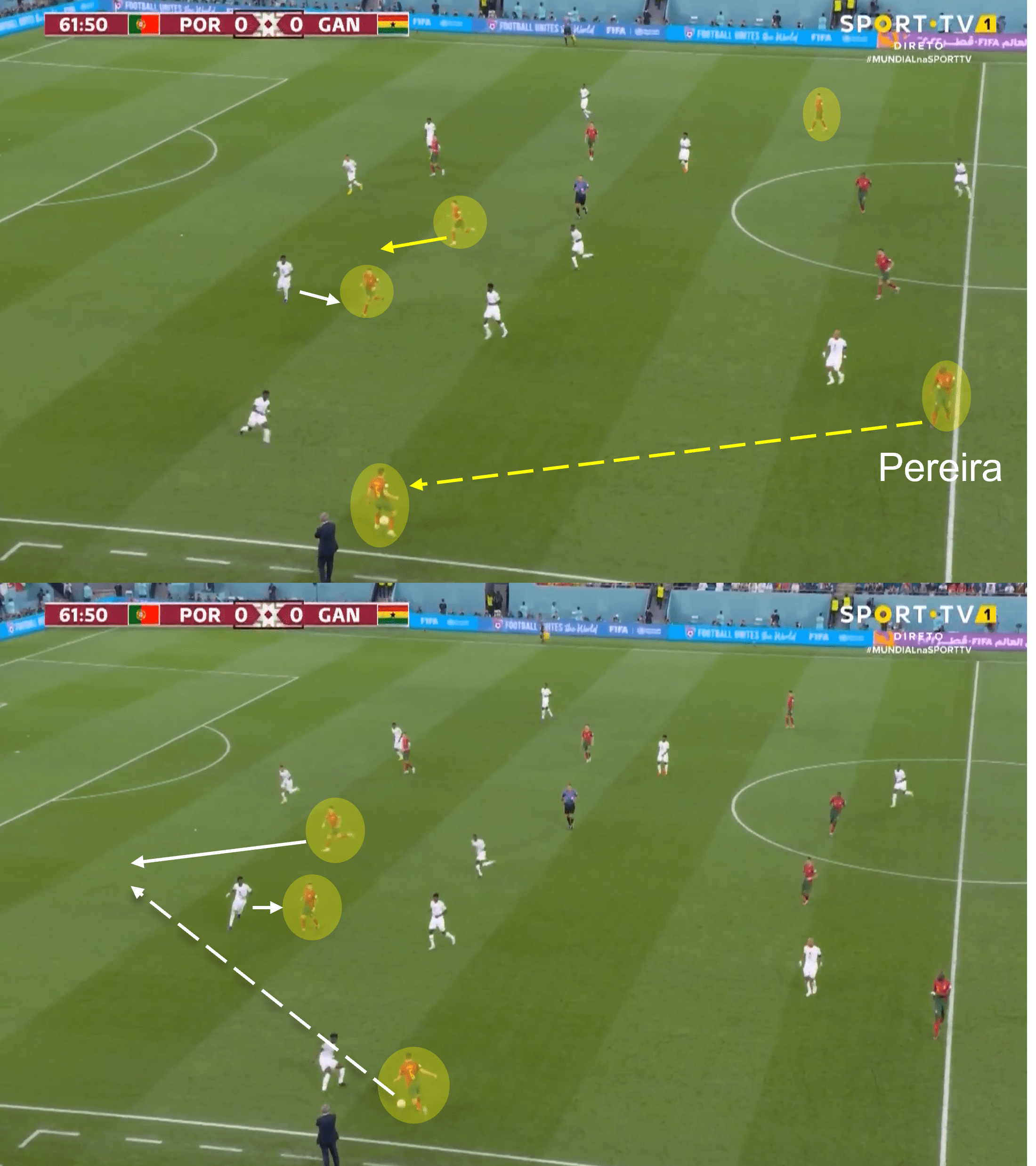
This final analysis of Portugal’s attacking tactics shows an incredible example of movement off the ball. Sticking with their method of dominating the ball in Ghana’s half and stretching their opponents by staying wide on both flanks, they found more space to break into as the game grew older.
This move started with Pereira playing a pass out to Guerreiro. Pereira operating in a back four for Portugal is interesting, as from nearly 400 career games under his belt, 325 of them have seen him play as a defensive midfielder and only 52 games as a central defender. It’s clever, though – his combination of defensive ability and talent on the ball, along with being 6”2”, makes for a good central defender for a team with these types of tactics.
Guerreiro shows good vision from the left flank to use the close option of his marked teammate as a decoy as the Ghana defender only had eyes for marking and seemed unaware of the space he was leaving behind. Guerreiro picked his pass with good execution and timing as he lofted the ball into Felíx who showed his real technical talent with a deft touch past his marker, into the path of Ronaldo. It was here that Ronaldo came under a small amount of contact and hit the deck, causing VAR to award a very soft penalty. Ghana boss Otto Addo said that this decision cost his team a point.
Ghana’s defensive depth before and after going behind
Well aware of Portugal’s talent and usual game plan, Ghana set out with caution but not fear in the early stages of the game. While their overall defensive positioning and organisation were not perfect, the game plan was to stifle Portugal’s possession and limit their chances to break into the box. We saw a variation in how they operated off the ball, using mid-blocks, low-blocks, and high pressing – dependent on a number of factors, which is included in the analysis below.
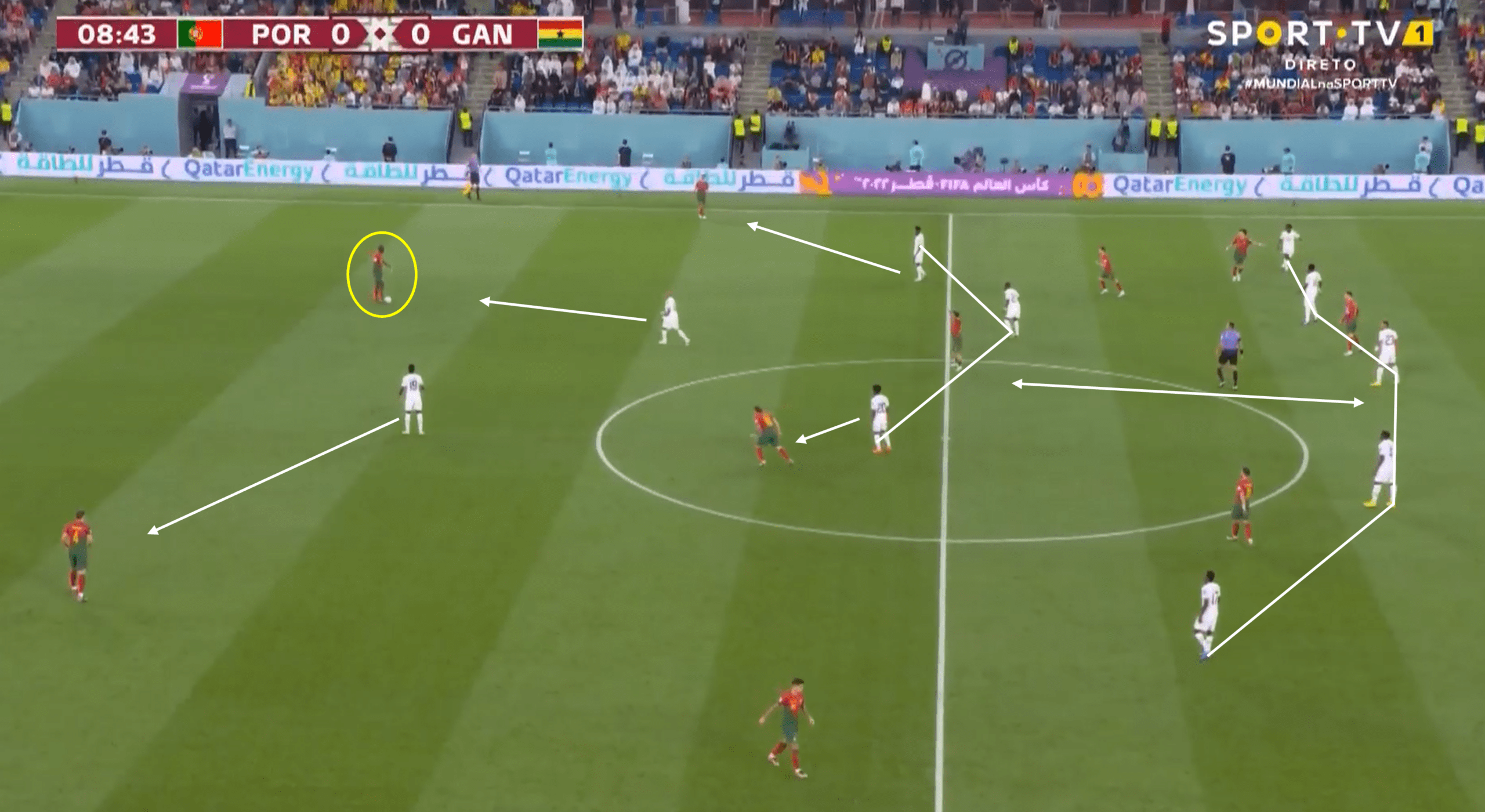
Early on, Ghana’s primary focus seemed to be denying Portugal an early goal. They did this with minimal pressing in areas as seen above but were reluctant to roll over and sit deep. Often, a compact mid-block was their choice of weapon, looking to give Portugal’s forwards and midfielders very little room.
Their strikers would act with minimal pressure – this was to try and keep close distance with their midfield unit to suffocate the Portuguese’s space even more. The back five would remain fairly compact, with one of the wing-backs positioned slightly higher and wider to mark space.
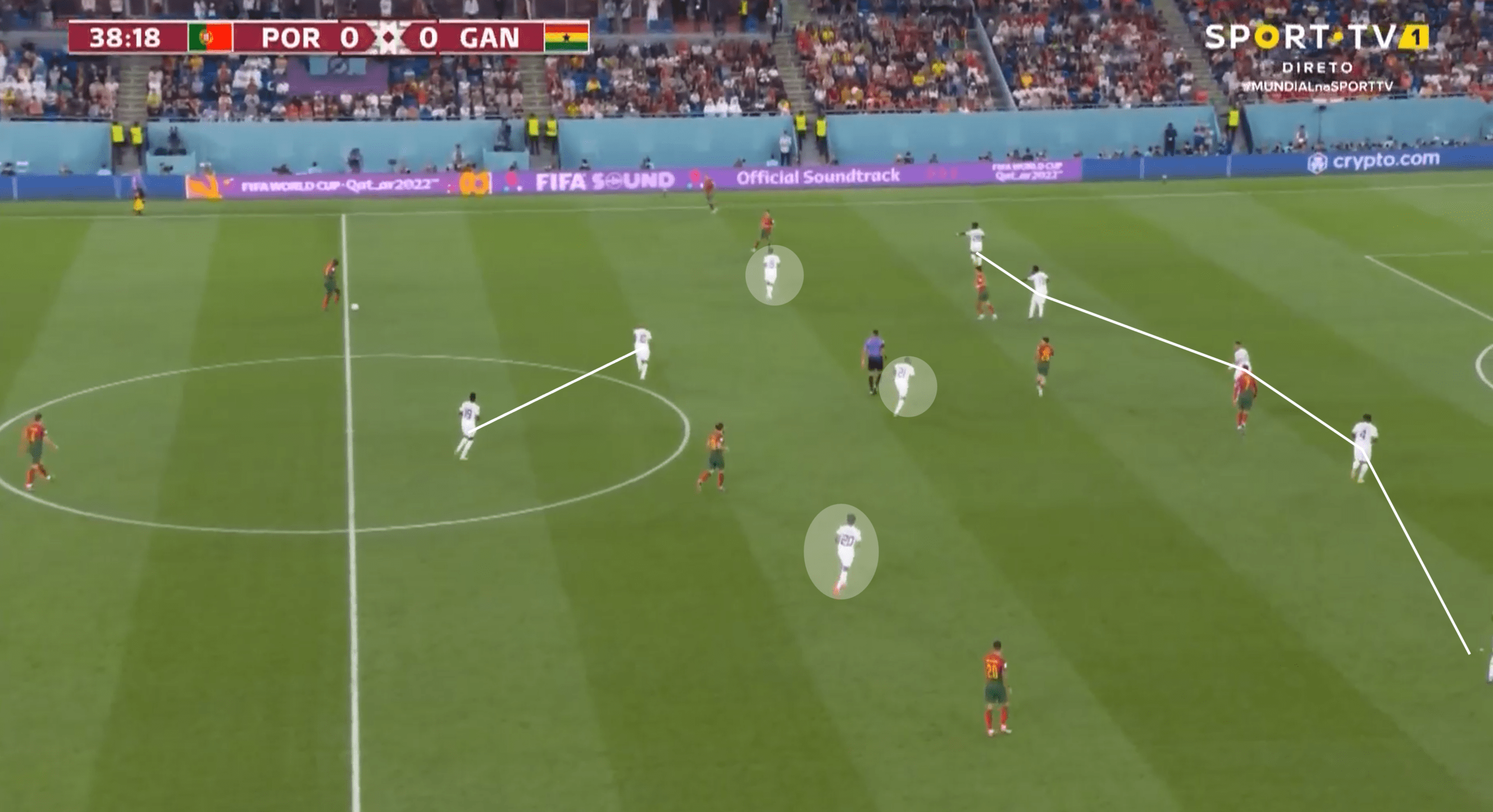
As much as Ghana didn’t want to drop deeper when defending, sometimes you are simply forced into it when you’re facing a team of Portugal’s quality. With Portugal further up the pitch than in the previous image, their attacking shape would naturally grow wider, meaning Ghana had to sacrifice some of their compact shape.
Their back five in particular grew wider, which would force the reaction of the midfield unit to drop deeper to give some of that defensive stability back. And of course, in turn, this would see the strikers follow suit in dropping into their own half. It wasn’t all doom and gloom for Ghana though just because they dropped a little deeper: they still closed down and marked effectively for the most part in the final third & penalty area.
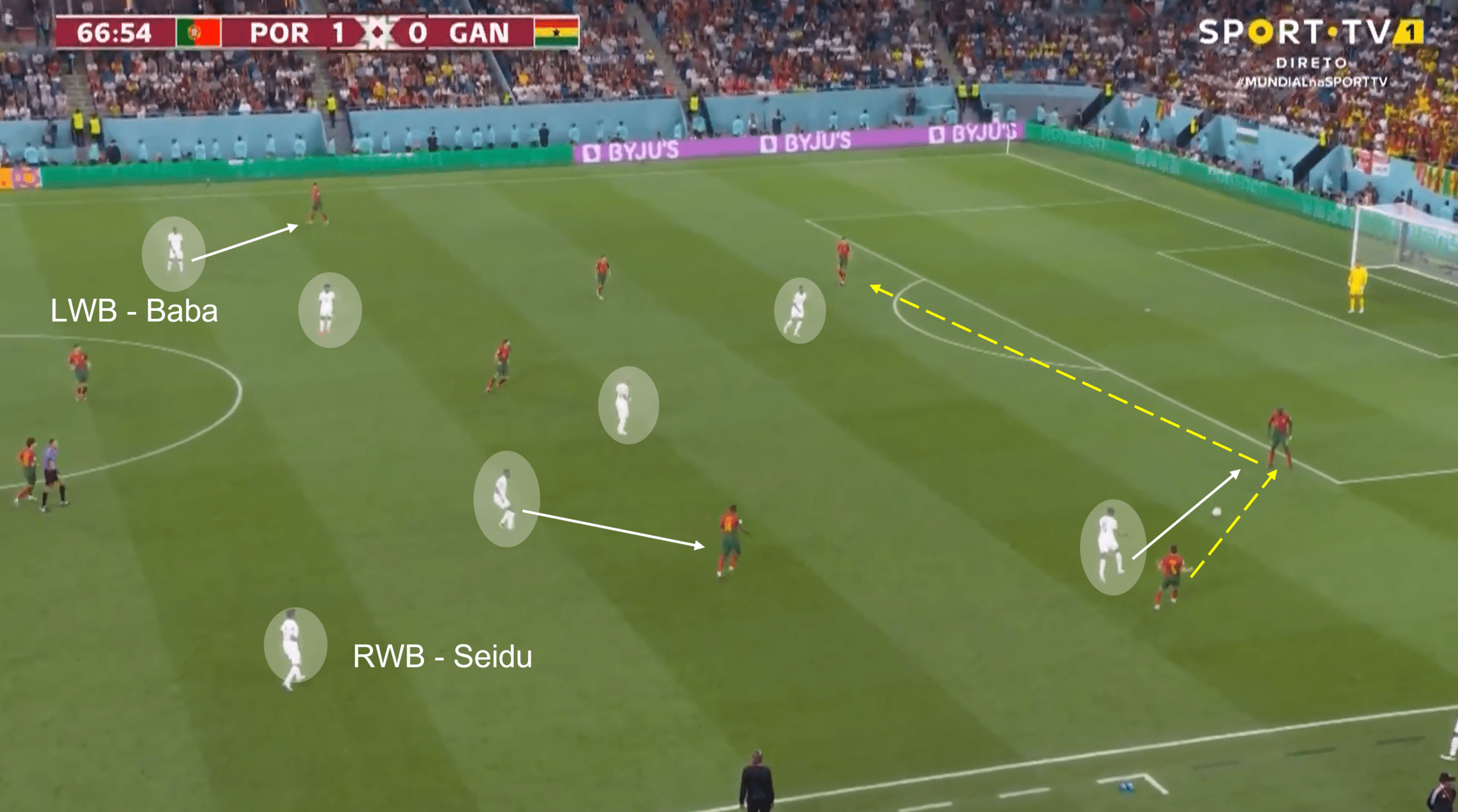
We saw more urgency and purpose off the ball from Ghana after Portugal had taken the lead through that controversial penalty. Portugal must have anticipated such a move, but they failed to deal with it convincingly at times.
In the analysis above, straight away the difference for Ghana is clear – a heavy presence from a variety of positions to give Portugal little to work with, and with the ball deep in their own half, this was a concern for them. Eventually, this press saw a turnover in possession in a dangerous area, but Ghana lacked the decision-making at that moment to make it count.
A clever move from Addo was to get his wing-backs to join the press, seeing them further up the pitch, marking Portugal’s full-backs or marking wide space that Portugal had previously used as an area to utilise. At times, this really limited Portugal’s progression building through the thirds as they looked to do in the first half. But, as mentioned previously, Ghana’s overall quality off the ball wasn’t always good enough, and of course, tiredness & fatigue came into play, which is why Portugal were able to score three goals in the final 25 minutes.
Their energy in the press was reflected in their approach play too though – high energy with urgency, they attacked Portugal with a more direct fashion, looking to break forward quickly and get the ball into the strikers even quicker.
Conclusion
Favourites for this contest and amongst the favourites for the whole competition, Portugal showed a lot of quality, especially going forward. However, it was far from a perfect performance, and they struggled with Ghana’s approach, especially when they increased the energy and intensity. The attitude and tactics of both teams made for an exciting spectacle, whether you’re supporting Portugal, Ghana, or if you’re neutral.
Portugal’s clever movement and link-up play could be their key asset going forward in this tournament, but they have work to do. Ghana will remain confident of taking points in their remaining group games but you would imagine they’d have to beat both South Korea and Uruguay to stand a chance of qualifying for the knockout stages.

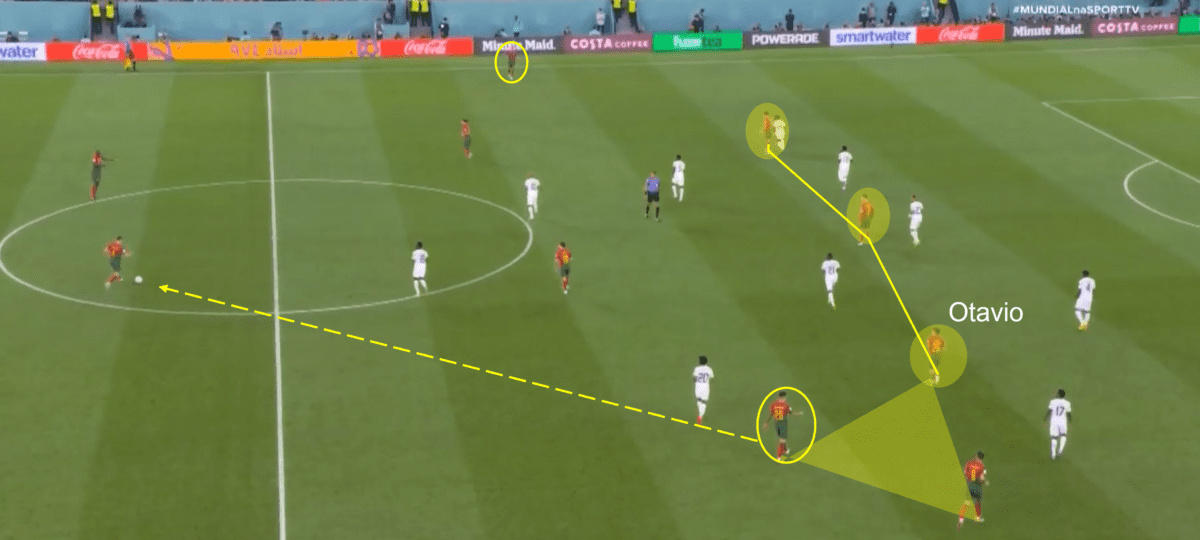

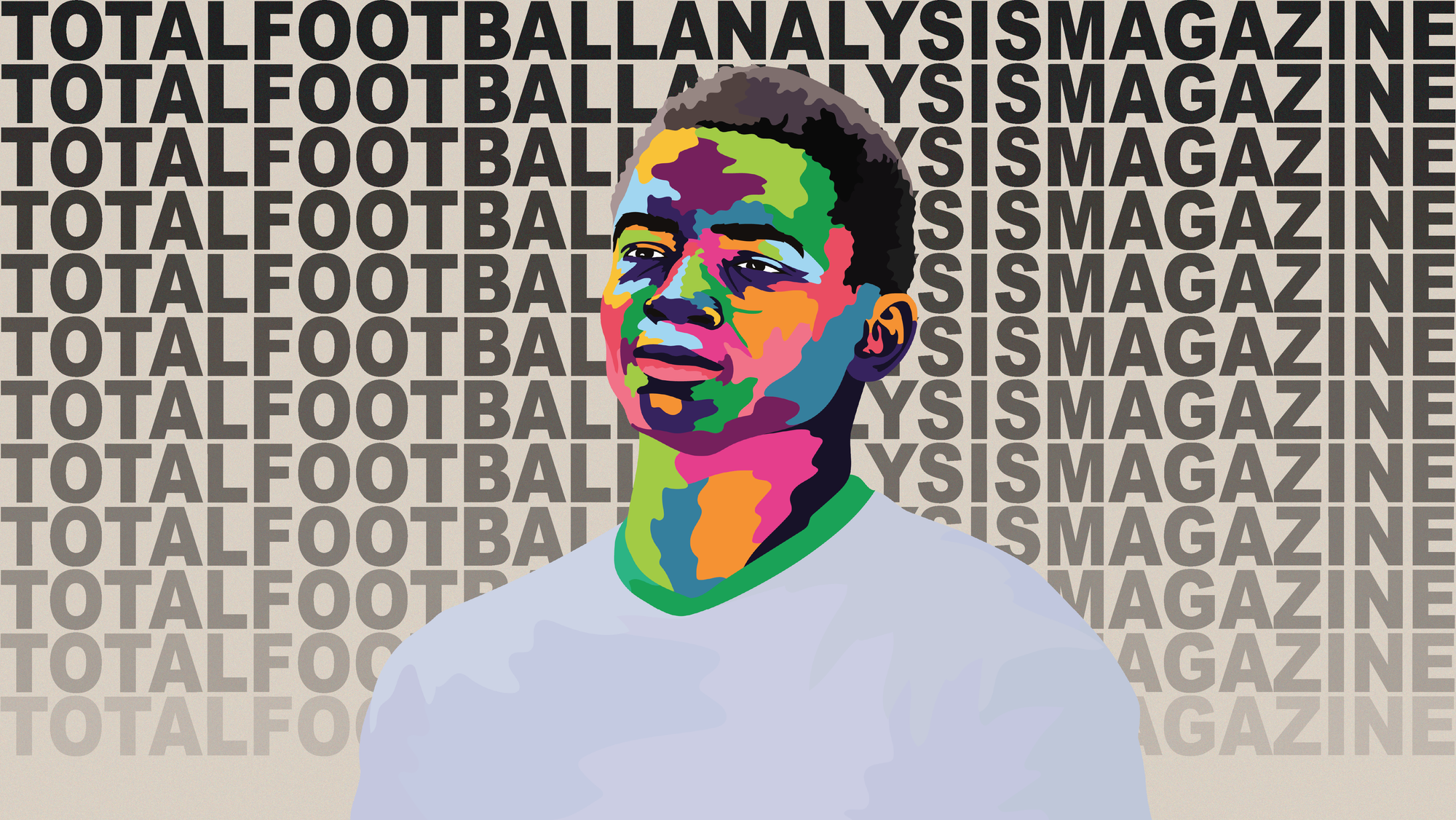
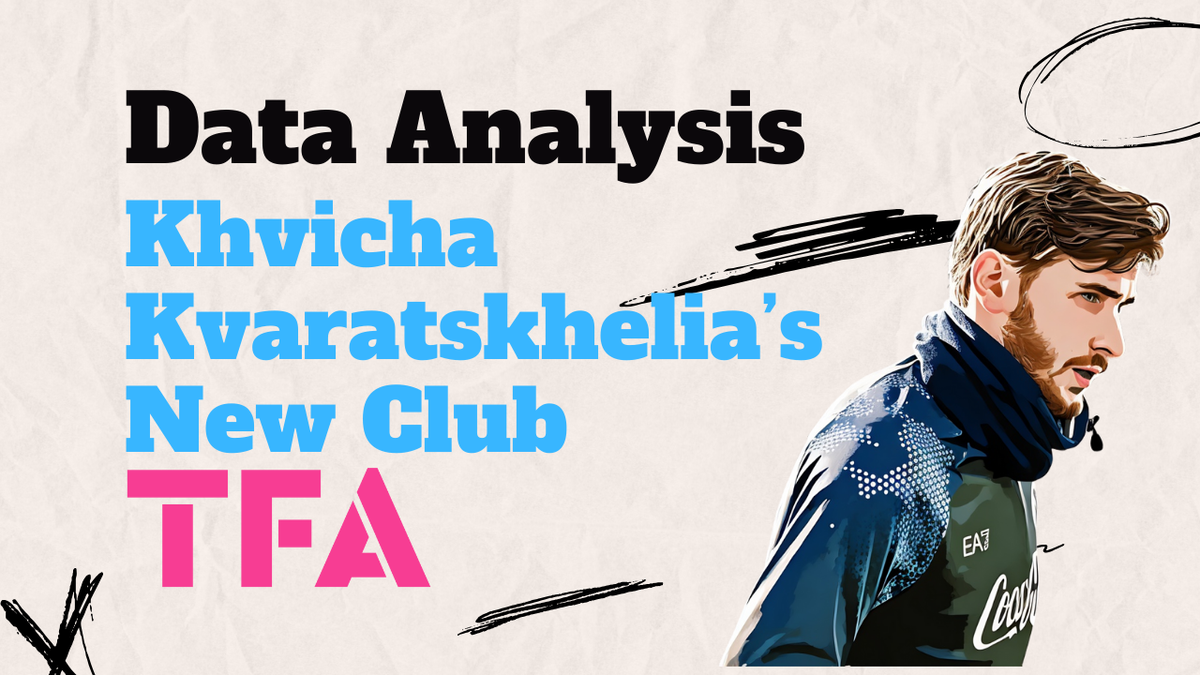

Comments